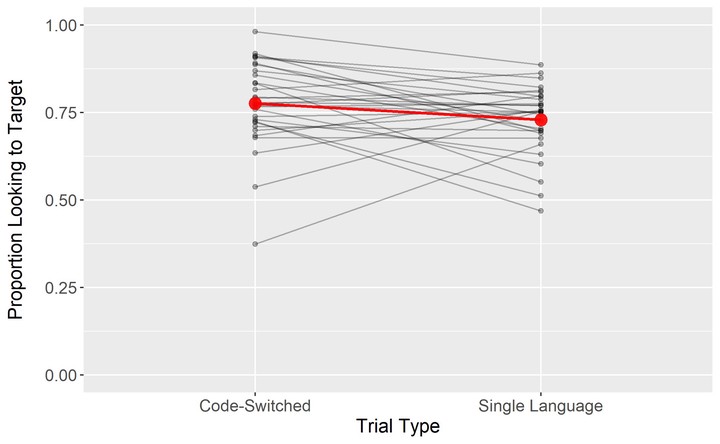
Abstract
Bilingual children hear sentences that contain words from both languages, also known as code-switching (Kremin et al., 2020). Investigating how bilinguals process code-switching is a crucial component in understanding bilingual language acquisition, because bilinguals experience processing costs and reduced comprehension when encountering code-switched nouns (e.g., Can you find the chien?; Byers-Heinlein et al., 2017; Potter et al., 2019). Studies have yet to investigate if processing costs are present when toddlers encounter code-switches at other syntactic locations within a sentence. Therefore, the current study examined how young bilinguals process sentences with code-switches at an adjective before the target noun.
Thirty bilingual toddlers (age range = 37 – 48 months) learning English and French or English and Spanish participated. Participants sat in front of a screen that simultaneously displayed a target and distractor image and heard either a sentence with code-switching at the adjective before the target noun (e.g., “Can you find la jolie cow?) or a single language sentence (e.g., “Can you find the pretty cow?”).
The proportion of time each child spent looking at the target image compared to the distractor image was calculated for each trial and averaged across trial types (See Figure 1). One-sample t-tests revealed participants looked to the target significantly above chance for both single language, t(29) = 12.566, p < 0.001, Md = 0.722, 95% CI [0.686, 0.758] and code-switched trials, t(29) = 11.907, p < 0.001, Md = 0.770, 95% CI [0.724, 0.817], suggesting toddlers correctly identified the target object in both trial types. A paired-samples t-test did not reach significance, but left open the possibility that bilingual toddlers may have performed differently across trial types, t(29) = 1.988, p = 0.056, Md = 0.048, 95% CI [-0.001, 0.098], which would imply that code-switching at an adjective could potentially boost comprehension of the target noun.
Bilingual toddlers accurately processed sentences that contained code-switching at an adjective, contrasting with previous findings that sentences containing code-switching lead to processing difficulties (Byers-Heinlein et al., 2017; Potter et al., 2019). These differences may be attributed to the information in the code-switch. In previous studies, the code-switch occurred at the target noun, so participants needed to process the code-switch to successfully identify the object. In the current study, the code-switch occurred at an adjective that participants did not need to process to identify the object. These findings suggest that the syntactic location of a code-switch and the information it carries are important components when investigating bilingual toddlers’ sentence processing.